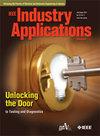Experimental Analysis of Transmission Line Protection Functions in Grid-Connected IBR
IF 4.2
2区 工程技术
Q2 ENGINEERING, ELECTRICAL & ELECTRONIC
引用次数: 0
Abstract
This paper investigates protection challenges for line current differential (87L) and distance protection function (21) posed by the integration of inverter-based resources (IBR) into transmission systems. The reliability of these functions is investigated in a weak in-feed system, where the IBR is the only source of fault current. The analysis of the protection schemes is performed on a real-world 25 bus network system, using a time-domain transient program (EMTP). The test system is interconnected with an IBR source, converted into a white-box model in accordance with IEEE 2800-2022 matching the negative sequence injection, phase angle, voltage ride through, and reactive power control strategy. The IBR response to 15 fault cases is simulated and tested against EMTP protection function models, then recorded into COMTRADE files. These files are used in a power system simulator to test the response of manufacturer's 87 L and 21 protection functions inside three different types of physical microprocessor relays. The following was concluded: the simulation tripping time response matches closely to the hardware tripping time response, the relaying philosophy used in the presence of synchronous generators is not sufficient due to the unique IBR fault response, the effect on overcurrent supervisors of 21 and 87 L relays must be carefully considered, and ground protection functions are impacted based on the presence of a grounding transformer in the IBR.求助全文
约1分钟内获得全文
求助全文
来源期刊

IEEE Transactions on Industry Applications
工程技术-工程:电子与电气
CiteScore
9.90
自引率
9.10%
发文量
747
审稿时长
3.3 months
期刊介绍:
The scope of the IEEE Transactions on Industry Applications includes all scope items of the IEEE Industry Applications Society, that is, the advancement of the theory and practice of electrical and electronic engineering in the development, design, manufacture, and application of electrical systems, apparatus, devices, and controls to the processes and equipment of industry and commerce; the promotion of safe, reliable, and economic installations; industry leadership in energy conservation and environmental, health, and safety issues; the creation of voluntary engineering standards and recommended practices; and the professional development of its membership.
 求助内容:
求助内容: 应助结果提醒方式:
应助结果提醒方式:


